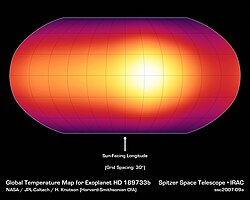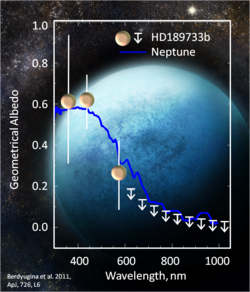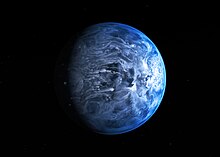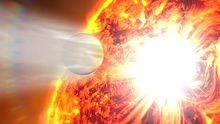
HD 209458 b is an exoplanet that orbits the solar analog HD 209458 in the constellation Pegasus, some 157 light-years from the Solar System. The radius of the planet's orbit is 0.047 AU, or one-eighth the radius of Mercury's orbit. This small radius results in a year that is 3.5 Earth-days long and an estimated surface temperature of about 1,000 °C. Its mass is 220 times that of Earth and its volume is some 2.5 times greater than that of Jupiter. The high mass and volume of HD 209458 b indicate that it is a gas giant.

HD 209458 is a star with an orbiting exoplanet in the constellation Pegasus. It has an apparent visual magnitude of 7.65 and an absolute magnitude of 4.28. Because it is located at a distance of 157 light-years from the Sun as measured via parallax, it is not visible to the unaided eye. With good binoculars or a small telescope it should be easily detectable. The system is drifting closer with a heliocentric radial velocity of −14.8 km/s.
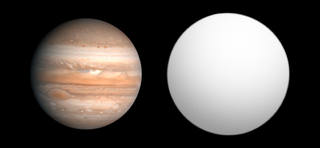
TrES-1b is an extrasolar planet approximately 523 light-years away in the constellation of Lyra. The planet's mass and radius indicate that it is a Jovian planet with a similar bulk composition to Jupiter. Unlike Jupiter, but similar to many other planets detected around other stars, TrES-1 is located very close to its star, and belongs to the class of planets known as hot Jupiters. The planet was discovered orbiting around GSC 02652-01324.

Hot Jupiters are a class of gas giant exoplanets that are inferred to be physically similar to Jupiter but that have very short orbital periods. The close proximity to their stars and high surface-atmosphere temperatures resulted in their informal name "hot Jupiters".
HD 74156 is a yellow dwarf star in the constellation of Hydra, 187 light years from the Solar System. It is known to be orbited by two giant planets.
HD 179949 is a 6th magnitude star in the constellation of Sagittarius. It is a yellow-white dwarf, a type of star hotter and more luminous than the Sun. The star is located about 90 light years from Earth and might be visible under exceptionally good conditions to an experienced observer without technical aid; usually binoculars are needed.
HD 114386 is a star with a pair of orbiting exoplanets in the southern constellation of Centaurus. It has an apparent visual magnitude of 8.73, which means it cannot be viewed with the naked eye but can be seen with a telescope or good binoculars. Based on parallax measurements, the system is located at a distance of 91 light years from the Sun. It is receding with a radial velocity of 33.4 km/s. The star shows a high proper motion, traversing the celestial sphere at an angular rate of 0.318 arcsec yr−1.
HD 130322 is a star with a close orbiting exoplanet in the constellation of Virgo. The distance to this system is 104 light years, as determined using parallax measurements. It is drifting closer to the Sun with a radial velocity of −12.4 km/s. With an apparent visual magnitude of 8.04, it is too dim to be visible to the naked eye; requiring binoculars or a small telescope to view. Being almost exactly on the celestial equator the star is visible everywhere in the world except for the North Pole. The star shows a high proper motion, traversing the celestial sphere at an angular rate of 0.197 arcsec yr−1.
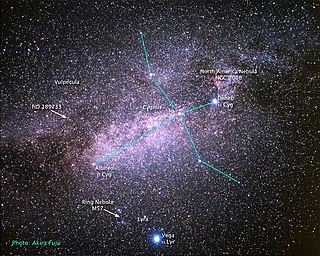
HD 189733, also catalogued as V452 Vulpeculae, is a binary star system 64.5 light-years away in the constellation of Vulpecula. The primary star is suspected to be an orange dwarf star, while the secondary star is a red dwarf star. Given that this system has the same visual magnitude as HD 209458, it promises much for the study of close transiting extrasolar planets. The star can be found with binoculars 0.3 degrees east of the Dumbbell Nebula (M27).
HD 38529 is a binary star approximately 138 light-years away in the constellation of Orion.

XO-1 is a magnitude 11 G-type main-sequence star located approximately 530 light-years away in the constellation Corona Borealis. XO-1 has a mass and radius similar to the Sun. In 2006 the extrasolar planet XO-1b was discovered orbiting XO-1 by the transit method using the XO Telescope.

XO-1b is an extrasolar planet approximately 536 light-years away from Earth.
Gliese 86 is a K-type main-sequence star approximately 35 light-years away in the constellation of Eridanus. It has been confirmed that a white dwarf orbits the primary star. In 1998 the European Southern Observatory announced that an extrasolar planet was orbiting the star.

HD 179949 b, formally named Mastika, is an extrasolar planet discovered by the Anglo-Australian Planet Search at the Anglo-Australian Observatory, which orbits the star HD 179949. The planet is a so-called "hot Jupiter", a Jupiter-mass planet orbiting very close to its parent star. In this case, orbital distance is almost one-tenth that of Mercury from the Sun. One orbital revolution lasts only about 3 days.

HD 80606 b is an eccentric hot Jupiter 217 light-years from the Sun in the constellation of Ursa Major. HD 80606 b was discovered orbiting the star HD 80606 in April 2001 by a team led by Michel Mayor and Didier Queloz. With a mass 4 times that of Jupiter, it is a gas giant. Because the planet transits the host star its radius can be determined using the transit method, and was found to be about the same as Jupiter's. Its density is slightly less than Earth's. It has an extremely eccentric orbit like a comet, with its orbit taking it very close to its star and then back out very far away from it every 111 days.

OGLE-TR-111b is an extrasolar planet approximately 5,000 light-years away in the constellation of Carina. The planet is currently the only confirmed planet orbiting the star OGLE-TR-111.

An exoplanet is a planet located outside the Solar System. The first evidence of an exoplanet was noted as early as 1917, but was not recognized as such until 2016; no planet discovery has yet come from that evidence. What turned out to be the first detection of an exoplanet was published among a list of possible candidates in 1988, though not confirmed until 2003. The first confirmed detection came in 1992, with the discovery of terrestrial-mass planets orbiting the pulsar PSR B1257+12. The first confirmation of an exoplanet orbiting a main-sequence star was made in 1995, when a giant planet was found in a four-day orbit around the nearby star 51 Pegasi. Some exoplanets have been imaged directly by telescopes, but the vast majority have been detected through indirect methods, such as the transit method and the radial-velocity method. As of 1 April 2024, there are 5,653 confirmed exoplanets in 4,161 planetary systems, with 896 systems having more than one planet. This is a list of the most notable discoveries.


